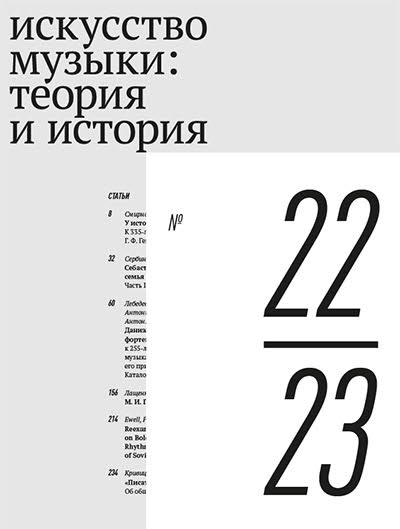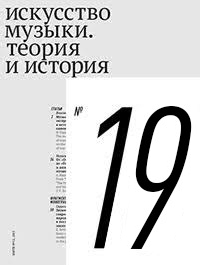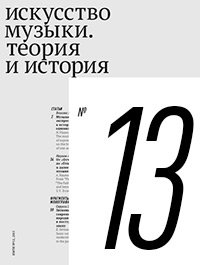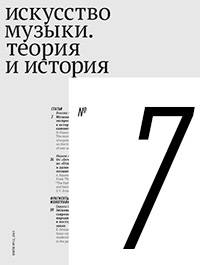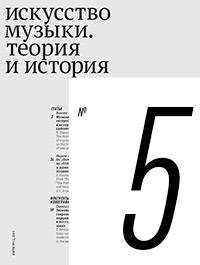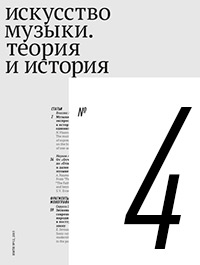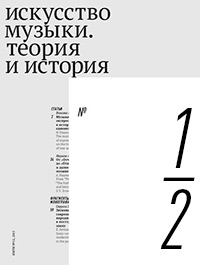2011 ¹¹ 1–2
FROM THE EDITORIAL TEAM
This is the first issue of a new musicological electronic periodical. Its objective is to reflect the multitude of problems of contemporary musical scholarship and to inform readers about new publications in the field. The journal’s format will allow to publish texts exceeding the standard length of scholarly article, including large excerpts from books in progress. The electronic journal’s distinctive feature is the presence on its pages of audio and video files, providing the opportunity to listen to the music touched upon in the published texts. The journal’s editorial board intends to enlarge the publication of materials in major European languages.
The materials and the information about the events of musical life have to be sent to the following address: imtijournal@gmail.com
L.H. Hakobian (Akopian), S.K. Lashchenko, M.G. Raku
The journal is published with the consent of the Scientific Council of the State Institute for Art Studies
The problems of history and theory of music operating with intervals lesser than semitone are discussed in five essays: “From the History of Micro-Chromaticism”, “The Micro-Space of Sound: the Acoustic and Aesthetic Foundations of Musical Systems”, “On Harmony on Miscro-Chromatic Music”, “Alois Hába’s Harmonielehre”, and “Micro-Chromatic Systems”.
The history of the first production of Musorgsky’s Boris Godunov at Mariinsky Theatre (1874) is discussed from the point of view of official institutions and performers engaged in the fortune of the work by a little known young Russian composer. The comparison of facts reveals new details and unexpected turns in the development of the universally known history. A special attention is paid to the circumstances that gave birth to the popular “myth about the opera Boris Godunov and its author, Musorgsky”. The article is a part of the research project “Russian Imperial Opera: Everyday Life”.
The article deals with the genre of musical battle (battaglia), which was very popular in the 18th and early 19th centuries. The most famous piece of this kind was Beethoven’s Wellington’s Victory, or the Battle of Vitoria. The article discusses the musical battles composed in Russia in the early 19th century. The peculiarities of the genre are described; some pieces by D. Steibelt, Pacini, and unknown authors are analysed. The article is supplemented with a catalogue of battle pieces published in Russia in 1812–28.
The article deals with the phenomenon of orientalism in Stravinsky’s opera The Nightingale (1908–1914). The work’s quasi-Chinese idiom is analysed in the context of the European tradition of chinoiserie; its evolution during the seven years of Stravinsky’s work on the opera is examined against the background of the artistic life in the early 20th century St Petersburg and Paris.
This is the first Russian biography of the Italian composer Giacinto Scelsi (1905–1988) – aristocrat and “barbarian”, ultra-modernist and neo-archaist, Catholic and Buddhist. The article introduces his music of all genres and creative periods and provides information on his aesthetic views and his world outlook. The article is a part of the author’s large research project dedicated to marginal figures of the 20th century music.
The paper discusses semantic reconsiderations of Bach’s aria “Erbarme Dich” (no. 47 from St Matthew Passion) in the framework of contemporary culture. In the late 20th and early 21st centuries Bach’s theme appears in different guises in various artworks: film soundtracks, academic musical compositions and “postmodernist” synthetic projects. The emblematic essence of “Erbarme Dich” crystallises in the context of cultural oppositions, such as sacred / profane, high / low, natural / artificial, and so on.
The article discusses the history, the semantical aspects, and the general peculiarities of the musical realization of the image of midnight from the 19th century to our times, including its contemporary “neo-Gothic” interpretations. An important reason for choosing such a topos as subject matter is the extreme character of the means commonly used for its depiction in music.
This text is a chapter of the forthcoming book from the series entitled “Glinka’s Wanderings”. Trying to comprehend the spirit of the epoch and to give a meaning to the forgotten or little known ideas and images croping up from the pages of Glinka’s memoirs, the authors explore texts by writers from different countries, depicting their reception of Spain. The travelogues of A. Dumas, V. Botkin, R. Ford, Th. Gautier, W. Irving, P. Mérimée and G. Sand, as well as the letters of F. Chopin and F. Liszt not only provide rich information about Spain, but also allow to sense the enthusiasm of pioneers in the face of new and uncommon land, which until the mid-19th century remained a kind of terra incognita for the most part of Glinka’s contemporaries.
This article is a part of the monograph Classical Music in the Soviet Era Myth Making, due for publication in Moscow (“Novoe Literaturnoe Obozrenie” publishing house). The article examines the influence of symbolist aesthetics, mediated by Wagnerian motives, on Pasternak’s novel Doctor Zhivago. The functioning of the motives in question in the novel has its roots in the reception of Wagner’s oeuvre by the culture of the Russian Silver Age.
This publication – an excerpt from the forthcoming book “Music in the Mirror of Philosophical Reflection of Islamic Civilization: Classical Theory and Contemporary Practice” – discusses the architectonics of musical speech as an image of the world. The main attention is paid to the heterogeneity of the philosophical reflection and classical theoretical thought of the 10th – 15th centuries and to the explanation of the differences in onthological principles, revealing to us two different musical images of world. Therefore our special objective is to establish the system-making factors of the interaction between musical language and musical speech, allowing to clarify the notion of “Islamic music” in the light of the special behavious of the basic structure known as maqām.






